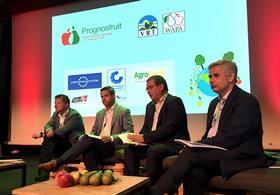
Attendees at the annual Prognosfruit conference, which took place this week in Alden-Biesen castle in eastern Belgium, heard that European topfruit production was expected to fall significantly this coming season.
Based on figures from early July – crucially before the heat wave that swept through northern Europe at the end of that month – the European apple crop is forecast to come in at approximately 10.5m tonnes, down from last year’s total of 13.2m tonnes.
However, difficulties in collecting data, including estimating the scale of quality and size issues, could mean a sizeable difference between the forecast and reality, according to Freshfel’s Philippe Binard.
“It is difficult to have a comprehensive idea of the crop because of localised weather events,” explained Philippe Appeltans, CEO of Belgian cooperative BelOrta. “Since the figures were provided, we have seen fruit affected by sunburn and hail. So we expect the volume to be 15 per cent lower for apples. For pears, the effect was less, but we might also see a decline of a few per cent.”
Polish apples are forecast to decline by 44 per cent compared with last year, tumbling from 4.8m tonnes to 2.7m tonnes, while Slovenia, Hungary, Austria and Germany are expected to record decreases of 35, 42, 22 and 17 per cent respectively.
Smaller decreases are anticipated in Italy, Belgium and the UK (of 2, 1 and 4 per cent respectively), while Spain, France and Netherlands are expected to see production rise by 14, 12 and 7 per cent respectively.
As for varieties, Idared, Jonagold and Jonagored all declined sharply, by 53, 25 and 60 per cent respectively, while Braeburn is expected to fall in the coming years as growers in countries including Italy switch to different varieties.
The European pear crop is forecast to fall from last year’s 2.4m tonnes to around 2m tonnes, the second lowest volume in a decade, with decreases recorded in all major pear-producing countries in the EU, except Spain.
According to Binard, the drop in pear production is largely due to an “exceptionally” low crop in Italy due to flowering issues and periods of high humidity, attracting pests, including the ‘stink bug’ that has hit Italian production and started to spread across Europe.
Italian production is expected to drop by 30 per cent to 511,000 tonnes, compared with a decrease of 10 per cent in Belgium, 14 per cent in France and 6 per cent in the Netherlands and Portugal. Of the main producing countries, only Spain is anticipated to register an increase, of 4 per cent, to 311,000 tonnes.
The Abate Fetel variety recorded a fall of 34 per cent year on year, which is predicted to benefit Conference pears, which declined by just 8 per cent. In Germany, the most important market in Europe, sales of Conference pears are increasing strongly, swiftly catching up with Abate Fetel.
“The autumn should see a good start for summer pears,” said Helwig Schwartau of market analyst AMI, “thanks to short overseas volumes and no EU stocks. The Conference is bigger in size than in 2018 and has a better shelf-life. This should be the basis for a successful season.”
This year’s Prognosfruit took place almost five years to the day since the Russian embargo came into force, compelling exporters to identify new alternative markets to compensate for the loss of the huge Russian market and avoid saturation in Europe.
According to Luc Vanoirbeek, secretary general of the Federation of Belgian Horticultural Cooperatives (VBT), Belgian exporters have been working to open up multiple new markets, including India, Indonesia, Israel and Vietnam for apples, and Brazil, Canada, China, India, Indonesia, Israel, Mexico and Vietnam for pears.
In addition, growers have been continuing their research into the development of new varieties and improving quality. “This is the answer,” Vanoirbeek said, “but it takes time.”



